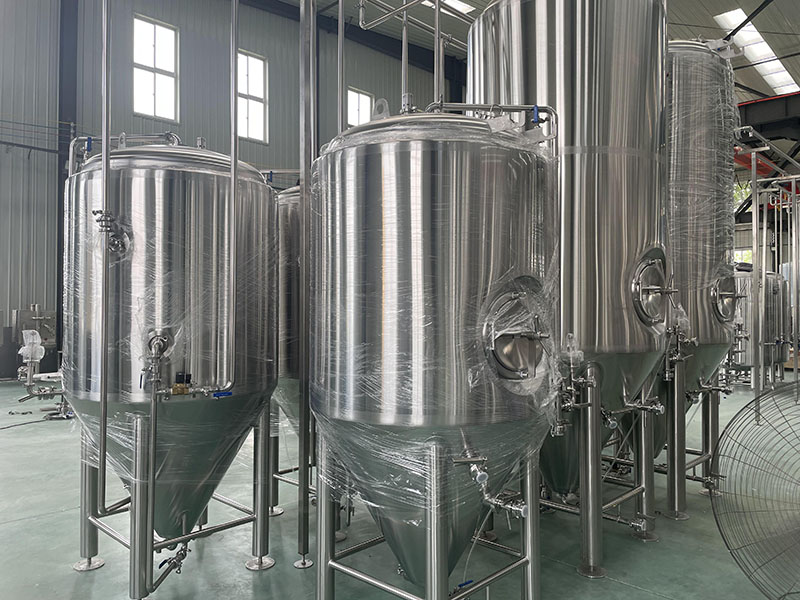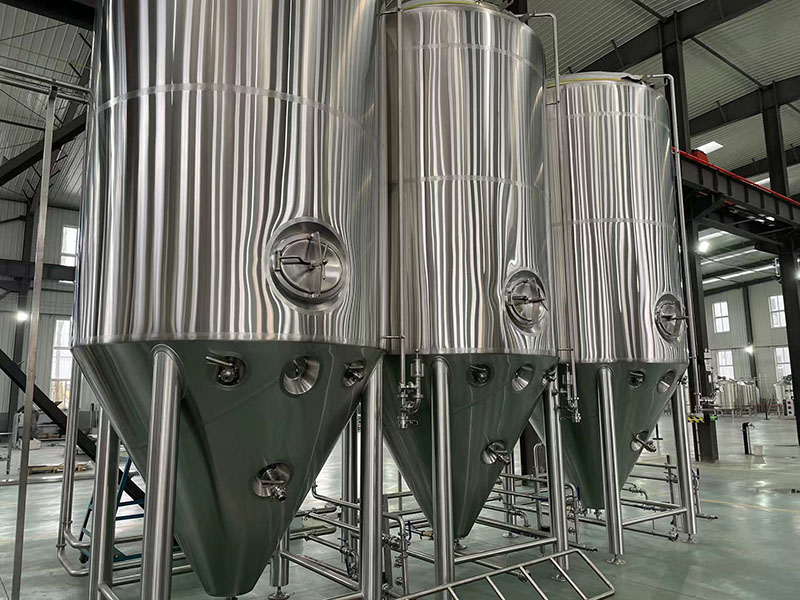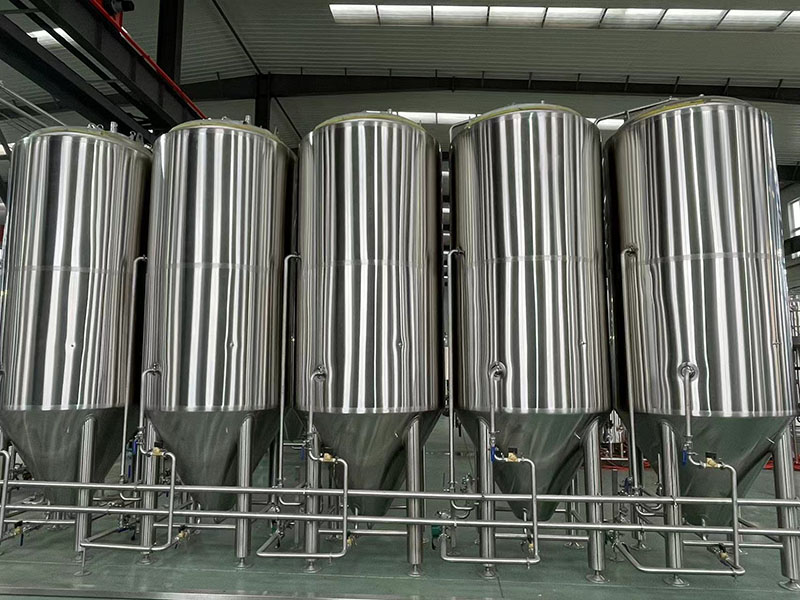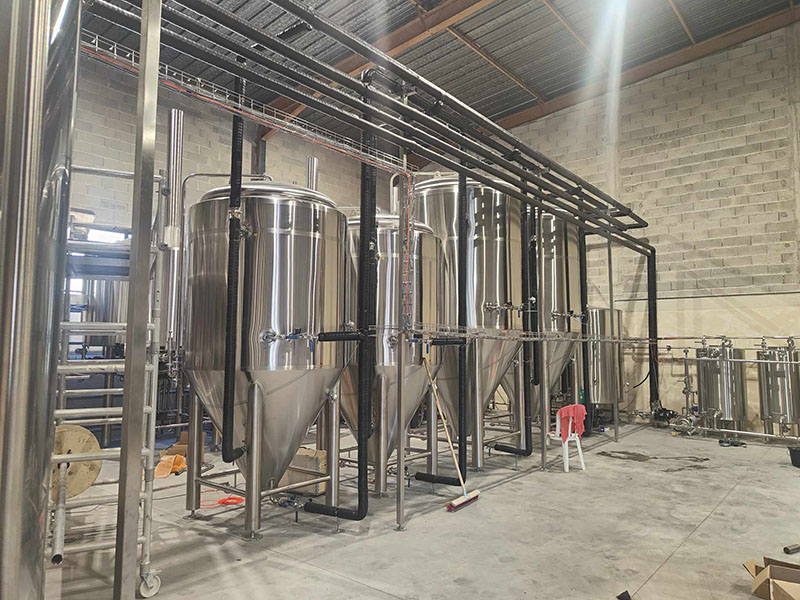1.Features of Beer Conical Fermenters
Conical fermenters, aptly named for their cone-shaped bottom, offer several distinct advantages over traditional fermentation vessels:
Improved Sediment Collection: The conical bottom allows yeast sediment, hop trub, and other particles to settle at the lowest point, away from the clear beer above. This makes it easier to transfer clear beer to a secondary fermenter or keg for carbonation, minimizing the risk of off-flavors.
Efficient Yeast Management: The conical design allows you to easily harvest yeast through a bottom valve. This harvested yeast can be reused for future batches, potentially saving you money and ensuring consistent results.
Simplified Dry Hopping: Some conical fermenters come with a dedicated dry hopping port, allowing you to add hops for aroma and flavor without introducing additional trub into the beer.
Temperature Control: Many conical fermenters are compatible with glycol jackets, which enable precise temperature control during fermentation. This is crucial for producing specific beer styles and ensuring optimal yeast performance.
Professional Appearance: Conical fermenters often have a sleek and professional aesthetic, adding a touch of sophistication to your home brewery.

2.The Brewing Process with Conical Fermenters
The basic brewing process remains the same with conical fermenters as with traditional carboys. However, the conical design offers some specific advantages during fermentation:
Primary Fermentation: Once your wort is cooled and transferred to the fermenter, yeast is pitched, and fermentation begins. The conical bottom allows CO2 to escape freely while keeping the yeast suspended in the wort for efficient conversion of sugars to alcohol.
Sediment Collection: As fermentation progresses, yeast and other particles settle at the cone’s bottom, leaving a clearer beer layer above.
Optional Dry Hopping (if your fermenter has a dedicated port): You can add hops at this stage for additional aroma and flavor without introducing excessive trub.
Yeast Harvesting (optional): If desired, you can harvest yeast through the bottom valve for future batches.
Transfer to Secondary (optional): If you plan to age your beer for an extended period, you can transfer the clear beer to a secondary fermenter, leaving the sediment behind.
Bottling or Kegging: Once fermentation is complete and the beer has clarified, you can bottle or keg it for enjoyment.
3.Pros and Cons of Conical Fermenters
Pros:
&Improved sediment collection
&Efficient yeast management
&Simplified dry hopping (with specific models)
&Improved sediment collection, leading to clearer beer with less risk of off-flavors.
&Efficient yeast management, allowing for yeast harvesting and reuse, potentially saving money and ensuring consistent results.
&Simplified dry hopping (with specific models), enabling easier addition of hops for aroma and flavor without introducing additional trub.
&Precise temperature control (with compatible models), crucial for producing specific beer styles and ensuring optimal yeast performance.
&Professional appearance, enhancing the aesthetics of your home brewery setup.
Cons:
&Higher cost compared to traditional carboys or buckets, especially for stainless steel models.
&Increased cleaning complexity due to the conical design and potential for hidden crevices where trub can accumulate.
&Larger footprint compared to carboys, requiring more storage space.
&May require additional equipment, such as a CO2 back pressure system and transfer pumps, for efficient use of some features.

4.Choosing the Right Conical Fermenter
Several factors come into play when selecting a conical fermenter for your brewery:
Size: Consider the batch size you typically brew and choose a fermenter with adequate capacity. It’s generally recommended to leave some headspace for krausen (foamy head) during fermentation.
Material: Stainless steel offers superior durability and temperature control.
Features: Decide whether features like a dry hopping port, glycol jacket compatibility, or a rotating racking arm are important to you.
Budget: Conical fermenters range in price depending on material, size, and features. Set a realistic budget and choose a fermenter that fits your needs and financial constraints.
5.Installation, Operation, and Maintenance of Conical Fermenters
Installing, operating, and maintaining a conical fermenter is generally straightforward, but it’s crucial to follow the manufacturer’s instructions carefully. Here’s a basic overview:
Installation:
Assemble the fermenter according to the instructions, ensuring proper placement of gaskets and seals.
Sanitize all equipment before use to prevent contamination.

Operation:
Transfer your wort to the fermenter and pitch your yeast.
Monitor the fermentation process, including temperature and gravity readings.
Optionally, dry hop your beer using the dedicated port (if available).
Harvest yeast (if desired) through the bottom valve.
Transfer clear beer to a secondary fermenter (optional) or directly to kegs or bottles for carbonation.
Maintenance:
Clean the fermenter thoroughly after each use using hot water, sanitizer, and a gentle brush.
Pay particular attention to the conical bottom and any crevices where trub might accumulate.
Regularly inspect the fermenter for any signs of damage or wear and tear.
Store the fermenter in a clean and dry place when not in use.

Conclusion
Conical fermenters offer a multitude of benefits for brewers, promoting cleaner beer, efficient yeast management, and a more professional brewing experience. By understanding the features, pros and cons, and key considerations when choosing a conical fermenter, you can make an informed decision that aligns with your brewing goals and budget. Remember, the most important factor is to have fun and enjoy the process of creating your own delicious craft beers!
Post time: Apr-02-2024

